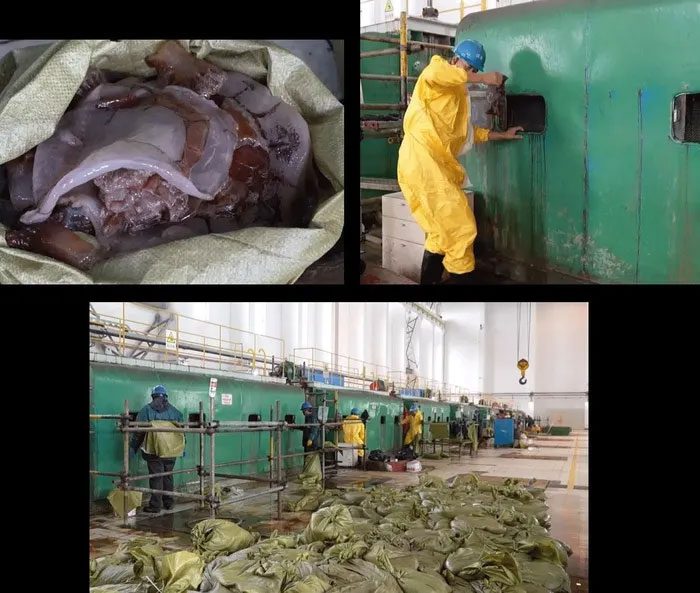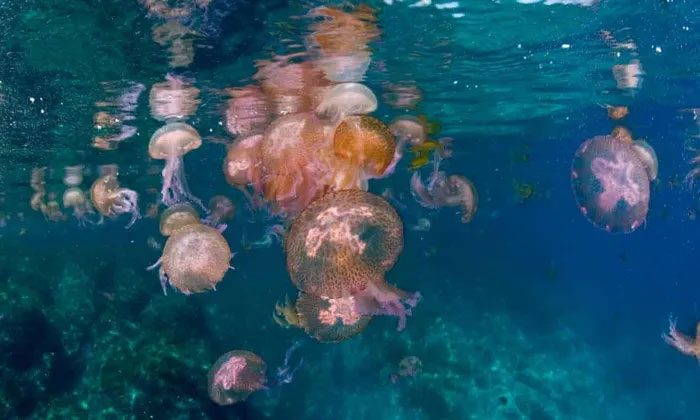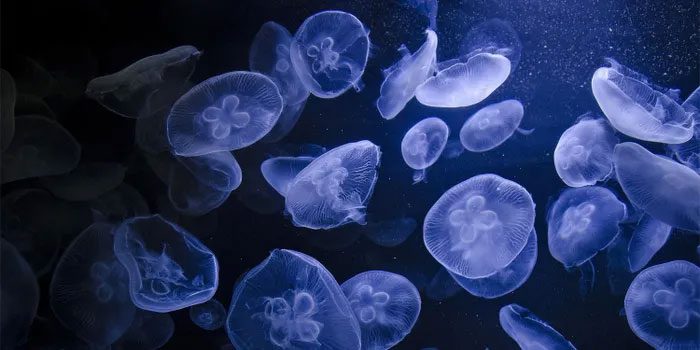A sudden influx of jellyfish has overloaded the cooling system, forcing factory workers to work around the clock to clear the chaos.
For 10 consecutive days and nights in September, workers at the largest coal-fired power plant in Eastern China battled against an “unprecedented invader”: a swarm of jellyfish.
At the Zheneng Jiaxing Power Plant in Zhejiang Province, teams of workers took turns urgently clearing millions of jellyfish that were invading the plant’s cooling system, threatening to halt operations.
Even after more than 150 tons of jellyfish were cleared from the plant—an overwhelming amount for local sanitation authorities—the jellyfish showed no signs of stopping.
Jellyfish continued to pile up, emitting a foul odor. Meanwhile, workers had to remove jellyfish from the filters by hand, one by one, making the task slow and arduous.
“In the 30-year history of the plant, we have never encountered anything like this,” Xi Chao, deputy director of the maintenance department, told CCTV on September 29.
Sea jellyfish, scientifically known as Rhopilema esculentum, has been a delicacy in China dating back to the Tang Dynasty (618-907). This year, the species has witnessed what local media described as an “unprecedented harvest in decades” along China’s coastal regions.
However, for the Zheneng Jiaxing Power Plant, this surge is not good news.
On September 18, a massive influx of jellyfish overwhelmed the plant’s circulating pump station, where seawater is drawn in to cool the generators. The jellyfish clung tightly to the rotating filters, clogging the intake pipes and overloading the filters, ultimately shutting down the generators.
The problem is not confined to this plant. In August, two nearby power plants in Shanghai faced similar jellyfish invasions. Even globally, Japan, South Korea, and the United Kingdom have encountered such disruptions over the past three decades.
Experts assert that the surge in jellyfish populations is indicative of broader global environmental changes. Factors such as nutrient-rich seawater—excess nutrients that lead to “algal blooms” (rapid increases in algae populations) and low oxygen conditions that favor jellyfish—and overfishing, which reduces competition among species, have allowed these organisms to thrive, causing devastation worldwide.
“Why not just eat them?”
News about the jellyfish crisis at the Zheneng Jiaxing Power Plant quickly went viral on social media, attracting over 41.69 million views on Weibo.
“Why not just eat them?” many netizens jokingly remarked, alluding to the long-standing history of R. esculentum as a popular delicacy in China.
Traditionally, this species is prepared as jellyfish salad, a staple dish in Chinese households for over 1,000 years. Ironically, the quantity of jellyfish collected from the power plant could produce at least 300,000 servings, if not left to rot in trash bags.

Jellyfish invade a power plant in Zhejiang, China.
Once considered a symbol of abundance, this jellyfish species has now become a representation of destruction.
“In the past, if we saw an increase in R. esculentum, it was not a disaster but a bountiful harvest,” Sun Song, former director of the Oceanographic Institute of the Chinese Academy of Sciences, told Sixth Tone. “However, this time, they have clogged the power plant, causing a crisis.”
Jellyfish have long been valued in China for their detoxifying, analgesic, and anti-inflammatory properties. In 1984, faced with declining jellyfish populations due to overfishing, China even took steps to replenish stocks and increase harvest yields by releasing cultivated jellyfish fry.
However, Xi, the deputy director of the plant, explained to Southern Metropolis Daily that they are unsure if the jellyfish clogging the plant are entirely edible, which prevents them from selling them to the public.
According to Sun, in addition to the edible species, China’s coastline often sees a surge of two other species—Aurelia aurita and Cyanea. Unlike the sought-after species, these are not considered edible and are often viewed as invasive or troublesome.
Destructive Species
In recent decades, the jellyfish explosion has become a global challenge, posing a serious threat to power plants worldwide.
“In fact, every power plant in the world has been attacked by jellyfish at some point; this is a global issue,” Sun, who has studied the species since 2005, explained.
He emphasized that nuclear power plants are particularly vulnerable. Unlike coal-fired plants, which can be shut down quickly, nuclear reactors require a gradual shutdown process. If jellyfish clog the intake pipes and cooling water is lost, the reactors face the risk of dangerous overheating, potentially leading to catastrophic explosions.
Since power plants are often built near coastal waters for access to cooling water, they are especially susceptible to marine invasions. This vulnerability has occurred repeatedly.

Jellyfish proliferation threatens coastal power plants worldwide.
In June 2011, Japan’s Shimane nuclear power plant had to deal with a jellyfish clogging issue. Next was the Torness nuclear power plant in Scotland, which faced another significant incident in October 2021.
In 2013, one of the largest nuclear reactors in the world, the Oskarshamn nuclear power plant in Sweden, had to shut down due to a jellyfish blockage in its cooling system, similar to an incident at a power plant in Israel in 2019.
Beyond power plants, jellyfish proliferation can significantly disrupt tourism activities, often ruining picturesque beaches. Along the renowned French Riviera, jellyfish stings have become a frequent concern during the summer, even with the installation of $84,500 jellyfish nets. Last summer alone, South Korea recorded approximately 2,900 jellyfish sting incidents.
A 2023 study shows that the threat from jellyfish has steadily increased over the past six decades, from the 1960s to the 2010s. The research found that jellyfish tend to thrive in bays and semi-enclosed seas.
Other studies indicate that jellyfish populations do not consistently increase but may follow a roughly 20-year cycle—a theory that requires further data for confirmation.
Solutions
Jellyfish thrive in areas where other marine species are weakened due to their unparalleled resilience in harsh environments.
“The biggest competitive advantage of jellyfish lies in their resilience in harsh environments. Essentially, they are opportunistic species,” Sun, a former member of the Oceanographic Institute of the Chinese Academy of Sciences, said, adding that Craspedacusta sowerbii, or peach blossom jellyfish—a species that has existed for 550 million years and survived multiple mass extinctions—is a prime example of their adaptability.
According to a 2009 study that first drew global attention to the phenomenon of “jellyfish blooms,” such resilience allows jellyfish to benefit from overfishing and nutrient runoff from fertilizers and wastewater.
Sun told Sixth Tone that both jellyfish and fish rely on zooplankton for food, but overfishing depletes fish stocks, creating opportunities for jellyfish to dominate the ecosystem. Increased nitrogen and phosphorus concentrations due to nutrient enrichment can lead to algal blooms and oxygen depletion—conditions that hinder fish survival but favor more resilient jellyfish.

Preventive measures against jellyfish blooms and attacks on power plants worldwide remain ineffective.
“Jellyfish can even eat fish eggs and fry. When large blooms occur, they will dominate the fishing grounds, making it difficult for other organisms to recover,” Sun said.
In 2015, a jellyfish bloom of Nomura jellyfish in Japan, weighing up to 200 kg each, caused flatfish catches to drop by 60%.
Jellyfish also have a unique life cycle. Before becoming free-floating jellyfish, they exist as polyps attached to the seafloor. These polyps can remain dormant for years, reproducing asexually until favorable water conditions trigger a sudden population explosion, Sun added.
Sun emphasized that the outbreak of jellyfish often goes unnoticed until they strike, making intervention options limited when the issue arises. He explained: “This is similar to wildfire prevention. Scientists can tell you why it occurs – it may be due to dry conditions or a stray spark. But once the fire breaks out, experts can do little; you need firefighters on the scene.”
Pointing out that awareness of measures to prevent jellyfish from clogging power plant pipes is still inadequate in China, Sun noted that both domestic and international efforts to manage and mitigate the hazards posed by jellyfish are continuously evolving.
In 2018, the Chinese Academy of Sciences proposed using zooplankton as bait to locate and scrape away the polyp regions of Aurelia aurita jellyfish. In South Korea, researchers have developed an “anti-jellyfish destroyer” – a robot capable of detecting and eliminating these creatures.
In the UK, drone technology has become part of an active early warning system, using drones at medium altitude to monitor and signal the movement of jellyfish towards power plants. A power plant in Japan has adopted a new approach, installing additional air pipes to create lift bubbles and redirect jellyfish away from water intake pipes.
Sun stated that to predict long-term trends, monitoring jellyfish polyps attached to the seabed remains a crucial strategy, as their presence indicates the potential scale of future outbreaks.
However, he acknowledged that much work remains to be done while observing the seabed. “In fact, we know less about the seabed than about the surface of the Moon.”

















































